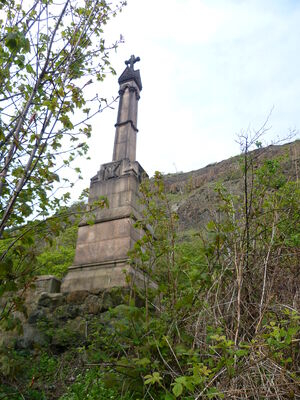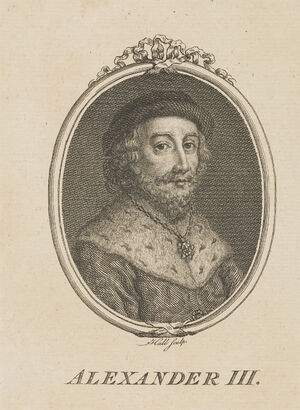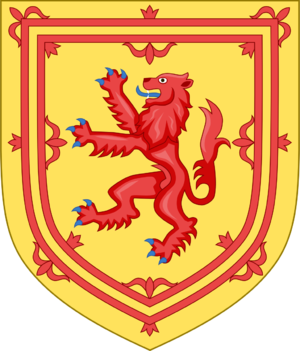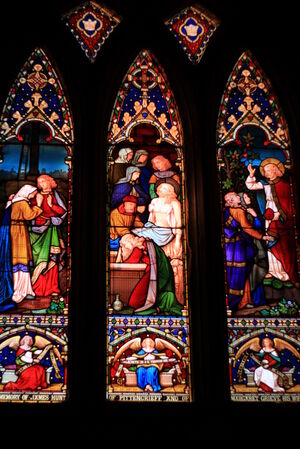| Alexander III (Dunkeld) King of Scots was a member of Scottish Nobility. Join: Scotland Project Discuss: Scotland |
| Preceded by Alexander II |
King of Scots 13 July 1249 - 19 March 1285/6 |
Succeeded by Margaret, Maid of Norway |
Biography
- “Ri Alban," "Alaxandair mac Alaxandair," "The Glorious,” “King of Alban,’' “King of Scotland,” “Roy descoce”'
- House of Dunkeld
Alaxandair mac Alaxandair Dunkeld was born on 4 Sep 1241 in Roxborough, Roxburghshire, Scotland, the son of Alexander II, King of Scots and his second wife, Marie de Coucy, the daughter of Enguerrand III de Coucy and his 3rd wife, Marie (Montmirail) de Coucy [1][2][3][4][5][6][7]
Accession as King
After the death of his father, Alexander II, King of Scots, on 8 July 1249, he was crowned on 13 Jul 1249 at the age of 7, as Alexander III, King of Scots at Scone Abbey, Perthshire and reigned until his death on 19 Mar 1286.[2][3][4][6][7][8][9]
First Marriage under Henry III
On 25 Dec 1251, he was knighted at York, Scotland by Henry III, King of England, Lord of Ireland, Duke of Aquitaine [2][4][5][7][8]
On the following day, 26 Dec 1251, at the age of 10, he married Margaret (Plantagenet) Princess of England, the daughter of King Henry III and Eleanor Provence of England. She died on 26 Feb 1274/5 in Cupar, Fife, Scotland.[2][3][4][5][6][8]
As Henry III suggested Alexander III, now his son-in-law, should render fealty for the kingdom of Scotland, Alexander cleverly responded, “That he had come into England upon a joyful and pacific errand, and would not treat upon so arduous a question without the advice of the Estates of his realm.” [10][7]
"The wedding prepared the ground for a coup." Walter Comyn and the earl of Mar (Domhnall I, also, Domhnall I, Earl of Mar) fomented unrest and were backed by King Henry III as "he sought an active role in Scotland." [11]
Henry III Deposes Regents and Scotland Government
By 1255, the young King and his Queen were under the protection of two two regents, Robert de Ros and John I de Balliol, barons of the Comyn Family, [12] which resisted King Henry’s continuing efforts to control Scotland. [10] However, King Henry in concert with various discontented Scottish nobles sent Richard de Clare, VIth Earl of Gloucester, and John Maunsell, Lord High Chancellor of England to Scotland to investigate grievances of Queen Margaret. She complained of her unsuitable living conditions and also the prohibition of conjugal intercourse with the king, who had reached the age of 14 years. King Henry’s agents and a party of the discontented nobles “procured the liberty of the King and Queen” and remedied the royal dissatisfactions. King Henry then dismissed the entire government of Scotland, removed them “from the King’s council and deprived them of their secular offices,” and, subsequently appointed Richard Inverkeithan, Bishop of Dunkeld, and other new regents. [6][8]
The Minor King and His Queen Reliberated
Before Alexander assumed his majority at age 21, changes in the regency and further political maneuvering occurred involving the faction of King Henry and the Comyns, chiefly, Walter Comyn, IVth Earl of Montieth [13] and Pope Alexander IV, who supported them. Ultimately, the Comyns contingent took the King and Queen under protection, seized control of the government, and by then King Henry was unable to respond. Fuller details are found in Dalrymple. [6][8]
Children of Alexander III and Margaret Plantagenet
- Margaret Dunkeld, b. 28 Feb 1261, Windsor, Berkshire, England; m. abt. 12 Aug 1281, Eric II Magnusson, King of Norway in Bergen, Hordaland, Norway, and crowned as Margaret, Queen of Norway ; d. 9 Apr 1283, In childbirth, Tønsberg, Vestfold, Norway; bur. Christ’s Kirk, Bergen, Hordaland, Norway. [2][3][4][5][8]
- Alexander Dunkeld, b. 21 Jan 1264, Jedburgh, Roxburghshire, Scotland; m. 15 Nov 1282, Roxburgh, Roxburghshire, Scotland, Marguerite of Flanders, daughter of Guy de Dampierre, Count of Flanders, Marquis of Namur and his 2nd wife, Isabelle de Luxembourg, daughter of Henry IV, Count of Luxembourg and La Roche, Marquis of Arlon, There were no children, and he predeceased his father; d. 17 (or 28) Jan 1283, Lindores Abbey, Fife, Scotland; bur. Dunfermline, Fife, Scotland [2][3][4][5][8]
- David Dunkeld, b. 20 Mar 1273; d. June 1281, Stirling Castle, Stirling, Stirlingshire, Scotland; bur. Dunfermline, Fife, Scotland; unmarried [2][3][5]
Norway Invades Scotland
Unsuccessful at peaceful efforts to wrest control of the Southern Islands from Norway, Alexander II, King of Scots died in 1249, while preparing for war. By 1262, Alexander III, King of Scots zealously adopted his father’s planning and raided Norwegian territory, including the Island of Skye, with burning of barns and churches and the killing of men, women, and infants.
Håkon IV, King of Norway responded with a greatly superior invasion force of 160 ships and 20,000 warriors. This fleet massed at the Hebridean Island of Kerrera on 12 Aug 1262 and began plundering, hostage-taking, and deliberating with the Irish. Alexander strategically opened negotiations, ceasing and delaying attacks by the Norwegian Fleet.
By September, Håkon lost patience with Alexander’s subterfuge and resumed the offensive, but the violent autumn storms arrived damaging his fleet and driving ships ashore. On 30 Sep 1263, The Scots attacked, known as the “Battle of Largs,”[14] killing the disorganized and weakened troops and looting beached ships. The damage from the storm and the Scottish onslaught was so great that that Håkon and his priests and clergy “believed that there was witchcraft in the matter, and that the Scotch had invoked the storm upon them.” [15] Alexander declared a great Scottish victory. Håkon withdrew his still strong fleet to Orkney for winter preparations and a spring resumption of the war.
Lamenting the excessively damp Orkney climate, Håkon IV, King of Norway died there on 16 Dec 1263, ending the invasion.[15][16][6][4][7][8]
Norway Cedes the Western Islands to Scotland
On 2 Jul 1266, Magnus, VI, King of Norway, son of Håkon, not able to resume the war, ceded the Western Isles, or Sudreys, and the Isle on Man to Scotland for a payment by treaty at Perth, Scotland. [2][7][8]
Coronation of King Edward I, King of England
On 19 Aug 1274, Alexander III, King of Scots and his wife, Margaret (Plantagenet) Queen consort of Scots attended the coronation of King Edward I at Westminster Abbey in London, England.[4][7][8]
Second Marriage
“For he [Alexander] used never to forbear on account of season or storm, nor for perils of flood or rocky cliffs, but would visit, not too creditably [both] matrons and nuns, virgins and widows, by day or by night as the fancy seized him, sometimes in disguise, often accompanied by a single follower.” [17]
On 14 Oct 1285, in Jedburgh, Roxburghshire, Scotland, he married 2nd, Yolande de Dreux, daughter of Robert IV, Count of Dreux, Braine, and, in right of his wife, Count of Montfort-l’Aumary, and Béatrice, daughter and heiress of Jean I, Count of Montfort-l’Aumary. There were no children. [2][3][4][5][7][8]
Death
“The protracted feast having come to an end, he [Alexander] would neither be deterred by stress of weather nor yield to the persuasion of his nobles, but straightway hurried along the road to Queensferry, in order to visit his bride, that is to say Yoleta, daughter of the Comte de Dru…” [17]
On 19 Mar 1286, Alexander III, King of Scots died at Kinghorn, Fife, Scotland,[2] when “it may have spooked, simply lost its footing or missed a turn on the shore path but Alexander’s horse fell and plunged with its rider over the cliffs. On the morning after the storm, searchers found the king’s body on the beach below. His neck had been broken.” He was buried at Dunfermline Abbey.[18] The Alexander III Monument, Kinghorn marks the site of the accident. [19][3][4][5][7][8]
“All the days of the life of this king, the Church of Christ flourished, her priests were honoured with due worship, vice was withered, craft there was none, wrong came to an end, truth was strong, and righteousness reigned,” John of Fordun. [8]
Sources
- ↑ Richardson, Douglas, Royal Ancestry: A Study in Colonial and Medieval Families, 5 vols., ed. Kimball G. Everingham (Salt Lake City: the author, 2013), vol. 4, 590-593.
- ↑ 2.0 2.1 2.2 2.3 2.4 2.5 2.6 2.7 2.8 2.9 Richardson, Douglas,Royal Ancestry: A Study in Colonial and Medieval Families, 5 vols., ed. Kimball G. Everingham (Salt Lake City: the author, 2013), vol. 4, 593-595.
- ↑ 3.0 3.1 3.2 3.3 3.4 3.5 3.6 3.7 Cawley, Charles, Medieval Lands: a Prosopography of Medieval European Noble and Royal Families, (Hereford, UK: Foundation for Medieval Genealogy, 2006) Chapter 3. KINGS of SCOTLAND (DUNKELD), B. KINGS OF SCOTLAND 1034-1290, ALEXANDER of Scotland,1. Alexander.
- ↑ 4.0 4.1 4.2 4.3 4.4 4.5 4.6 4.7 4.8 4.9 Dunbar, Sir Archibald H. Scottish Kings: A Revised Chronology of Scottish History 1005-1625. Edinburgh: D. Douglas (1899), 94-102, 280.
- ↑ 5.0 5.1 5.2 5.3 5.4 5.5 5.6 5.7 Paul, Sir James Balfour. The Scots Peerage; Founded on Wood’s Edition of Sir Robert Douglas’s Peerage of Scotland; Containing an Historical and Genealogical Account of the Nobility of That Kingdom. Edinburgh: D. Douglas (1904), vol. 1, 6.
- ↑ 6.0 6.1 6.2 6.3 6.4 6.5 Dalrymple, David. Annals of Scotland: From the Accession of Malcolm III in the Year MLVII to the Accession of the House of Stewart in the Year MCCCLXXI, to which are Added, Tracts Relative to the History and Antiquities of Scotland. United Kingdom: A. Constable (1819), 188-223.
- ↑ 7.0 7.1 7.2 7.3 7.4 7.5 7.6 7.7 7.8 electricscotland. Significant Scots Alexander, Kings I, II & III. Muskegon, MI: Electric Scotland USA LLC (2022), Alexander III.
- ↑ 8.00 8.01 8.02 8.03 8.04 8.05 8.06 8.07 8.08 8.09 8.10 8.11 8.12 Fordun, John of, Felix James Henry Skene, and W. F. (William Forbes) Skene. John of Fordun's Chronicle of the Scottish nation. Edinburgh: Edmonston and Douglas (1872), bk. v., chap. xxiv, 289-305.
- ↑ Anderson, Allan Orr, Early Sources of Scottish History A.D 500 to 1286, (Edinburgh: Oliver and Boyd, 1922), vol. 2, citing, “1249, Chronicles of the Kings of Scotland…,Alexander the son, a boy of seven years, was crowned at Scone on the third day before the Ides of July, by David, the bishop of St Andrews.” 562.
- ↑ 10.0 10.1 electricscotland. Comyn, Cumming. Muskegon, MI: Electric Scotland USA LLC (2022), Comyn, Cumming.
- ↑ Brown, Michael, The Wars of Scotland 1214-1371, The New Edinburgh History of Scotland, Volume 4 (Edinburgh: Edinburgh University Press, 2004), 47.
- ↑ Lynch, Michael, editor. The Oxford Companion to Scottish History. “Comyn family.” Oxford, UK: Oxford University Press (2011), 104-105.
- ↑ Tout, Thomas Frederick. Dictionary of National Biography, 1885-1900/Comyn, Walter. Wikisource. Wikimedia Foundation, Inc. (2020), vol. II.
- ↑ Lancaster, James. The battle of largs. www.castlesfortsbattles.co.uk (2019). https://www.englishmonarchs.co.uk/battle_largs.html.
- ↑ 15.0 15.1 Munch, Peter Andreas. The Norwegian invasion of Scotland in 1263/ a translation from Det norske folks historie, by P. A. Munch ; communicated to the Archaeological Society of Glasgow by Hugh Tennent. Glasgow: Bell & Bain (1862), chap. IV, 34-52.
- ↑ Johnstone, Rev. James. THE NORWEGIAN ACCOUNT OF HACO'S EXPEDITION AGAINST SCOTLAND; A.D. MCCLXIII. Edinburgh: William Brown (1882), MCCLXIII, par. 1-22.
- ↑ 17.0 17.1 Maxwell, Sir Herbert. The Chronicle of Lanercost, 1272-1346: Translated, with notes. Glasgow: J. Maclehose (1913), 40-41.
- ↑ Moffat, Alistair. Scotland: A History from Earliest Times. Edinburgh: Berlinn Limited (2015), Kindle Version, loc. 3005. [Kindle]
- ↑ Traynor, Kim. Alexander III Monument, Kinghorn © Kim Traynor CC-BY-SA/2.0. Geograph Britain and Ireland (2022), https://www.geograph.org.uk/photo/2370708.
See Also:
- Anderson, Marjorie O[gilvie]. Kings and Kingship in Early Scotland. (Edinburgh: Berlinn, 1973), 53, 59, 62, 66, 72, 74, 76, 214, 219-221, 238, 277, 285, 289, 291.
- Brown, Michael, The Wars of Scotland 1214-1371, The New Edinburgh History of Scotland, Volume 4 (Edinburgh: Edinburgh University Press, 2004) 20, 27, 44-67, 68, 81-8, 89-94, 124, 126, 127, 128-9, 130-1, 133, 136, 138, 143, 152-3, 154, 157, 159, 160, 161, 169, 192, 226-7, 252-3, 255, 257, 274, 289, 298, 306, 325, 337, 342, 344.
- Goodey, Emma, Alexander III (r. 1249-1286). The Royal Family, (London: The Royal Household, 2016). https://www.royal.uk/alexander-iii-r-1249-1286.
- Reid, Norman H., Alexander III, Oxford Dictionary of National Biography, (United Kingdom: Oxford University Press, 2004), Alexander III [Subscription].
- Spottiswood, John, The History of the Church of Scotland, beginning the year of our Lord 203, and continued to the end of the reign of King James VI, (R. Norton, for R. Royston, London, 1668) 44.
- Wikipedia contributors, Alexander III of Scotland, (Wikipedia, The Free Encyclopedia, 2023), Alexander III of Scotland.
- Wikipedia contributors, House of Dunkeld, (Wikipedia, The Free Encyclopedia, 2023), House of Dunkeld.
No known carriers of Alexander III's DNA have taken a DNA test.
Have you taken a DNA test? If so, login to add it. If not, see our friends at Ancestry DNA.
Featured National Park champion connections: Alexander III is 20 degrees from Theodore Roosevelt, 24 degrees from Stephanus Johannes Paulus Kruger, 20 degrees from George Catlin, 22 degrees from Marjory Douglas, 29 degrees from Sueko Embrey, 22 degrees from George Grinnell, 24 degrees from Anton Kröller, 21 degrees from Stephen Mather, 27 degrees from Kara McKean, 24 degrees from John Muir, 18 degrees from Victoria Hanover and 31 degrees from Charles Young on our single family tree. Login to find your connection.
D > Dunkeld | K > King of Scots > Alexander (Dunkeld) King of Scots
Categories: Scotland, Royalty | House of Dunkeld | Scotland Project Managed Nobility Profiles





Clyde, for the Scotland Project
Jen, for the Scotland Project
Thanks,
Clyde
Please be patient while this is being done, and if anyone has new sources they would like to share please message me or post here.
Thank you,
Clyde, for the Scotland Project